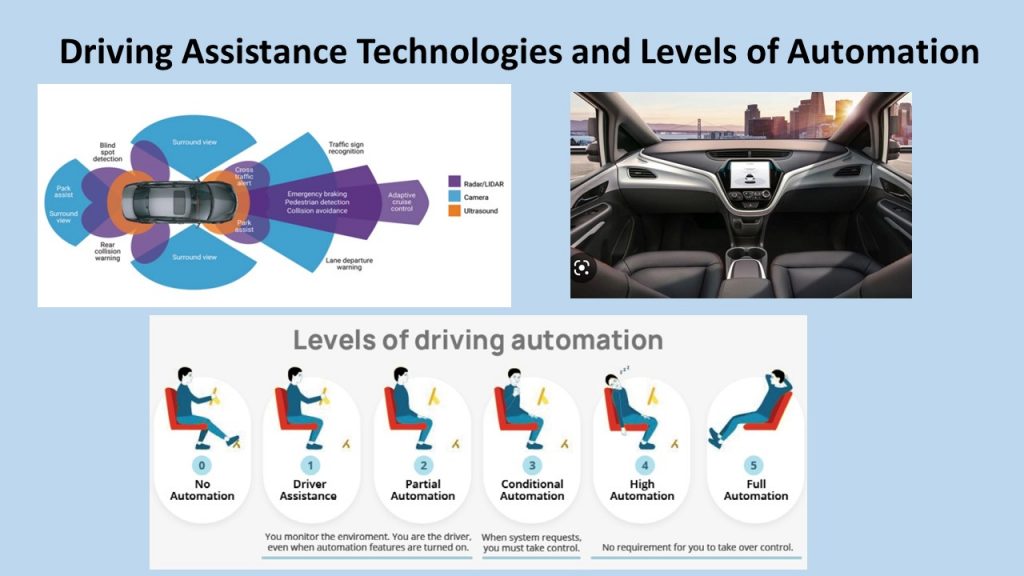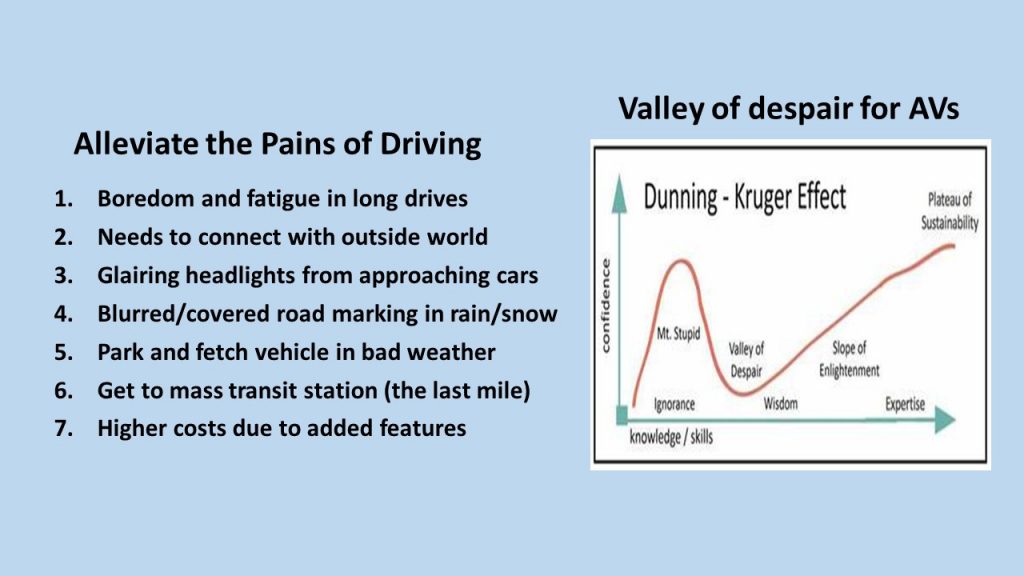
149. The Future of Autonomous Vehicles (AV) | 我心目中的自駕車
– Musings of Dr. Jamie C. Hsu, 5.11.2023
During this year’s Society of Automotive Engineers (SAE) conference, two hot topics were Autonomous Vehicles (AV) and Advanced Driver Assistance Systems (ADAS). The participants enthusiastically shared and discussed the technical merits of AV and ADAS, and the advancements in their schools, research institutes, and companies.
Unfortunately, such technologically focused efforts have not answered the three most important questions users are concerned about:
— How will such technology actually alleviate the pains or inconveniences of driving?
— What are consumers willing to pay for the newly added features and costs?
— Are there attractive business cases and ROI for companies to get into the AV business?
The engineers and researchers at the conference spent a lot of time debating the “5 levels of autonomous driving” (see Slide 1), and discussing technical, legal, and safety issues.
To the average driver, such definitions and technical descriptions are of less importance than knowing what problems can be solved for daily driving, and what the added costs are. Slide 2 lists some of the common complaints by regular drivers. As you can see, these issues are not adequately addressed by AV developers, who tend to showcase the AV’s performance on a low traffic environment or in a well-confined campus. Instead of such efforts, the industry and government’s focus should shift from pursuing higher Levels of Automation to expanding driver assistance capabilities. For each of the capabilities, a well-defined testing protocol and regulation should be developed and defined so the average driver will be “assisted” or “protected.” This is similar to the adoption of side impact protection, ABS (anti-lock brake systems), and cruise control systems.
A case in point is that many elderly people give up driving at night or on rainy days because of poor vision and road conditions. An ADAS system to assist people driving at night and in bad weather would be a most welcomed feature.
By adding more well-defined driver assistance features, we can gradually advance to true autonomous driving where no steering wheels or brake pedals are even required in vehicles. In addition, with the vehicle’s ability to see, sense, and react automatically to avoid crashing, the requirements for headlights, structural bumpers, and side beams will diminish. Over time, protective hardware and mechanical linkages will be replaced by sensors, software, and by-wire technologies, and the costs of such vehicles will change, but they will not necessarily be higher.
For the future of AV, we must focus on alleviating drivers’ real pains and on shifting the costs from hardware to software. Then we can avoid the hype and “despair valley” for AV and begin to climb the sustainable growth curve.
Let’s focus on solving real problems, rather than incentives, publicity, and technical stunts. A sustainable future of AV will be in the sweet spot of solving consumers’ pains, developing innovative technical solutions, and creating viable business models. I hope we will work together to create AV and ADAS that can truly benefit consumers, the environment, and society.


我心目中的自駕車 (2023/05/11)
–作者 許俊宸博士
–中譯 薛乃綺
在今年的汽車工程師學會(SAE)會議上,自動駕駛車輛(AV)和先進駕駛輔助系統(ADAS)仍是兩個熱門話題。參與者熱情地分享和討論AV和ADAS的技術優點以及他們所在的學校、研究機構或企業的研发進展。
然而,這些技術聚焦的重點並沒有真正回答消費者最關心的三個關鍵問題:
-這項技術實際上如何降低駕駛者的痛苦或不便?
-消費者願意為這些新增的功能及成本付出多少錢?
-是否存在具吸引力的商業實例或‘有感’的投資回報率,能讓企業願意/持續支持或投入自駕車業務?
在SAE會議上,工程師和研究人員花了很多時間討論“五個自動駕駛等級”(如附圖1所示),並討論技術、法律和安全問題。但對於一般駕駛者來說,與其去争辩這些定義和技術描述的重要性,倒不如先了解它能解決哪些日常駕駛中常見的問題、以及避免增加的成本。附圖2列出了一些駕駛者的常見抱怨。如您所見,自駕車技術研發者往往在交通量較低的環境、或較狹小的園区中,展示自駕車的性能;但前面提到的問題仍然不會因此而獲得充分解決。相對地,產業界和政府當局應該把焦點從追求更高的自動化水準、轉向擴展駕駛輔助能力。對於每一種能力,應該制定並發展一個具體的測試協議以及規範,以便一般的駕駛者就能因此獲得“輔助”或“保護”。這與过去採用側面碰撞保護、ABS(防鎖死煞車系統)和定速巡航系統的情況類似。
舉個例子來說,因為視線不好和道路狀況不佳,許多年長者在夜間或下雨天放棄駕駛。由此可見,如果有一個駕駛輔助系統,能協助人們在夜間或惡劣天候下仍可駕駛車輛,肯定是會受到歡迎的。
隨著增加更多這樣明確定義的駕駛輔助功能,我們可以逐步發展真正的自動駕駛技術,到达車輛不再需要方向盤或煞車踏板。此外,隨著車輛能夠自動感知和反應以避免發生碰撞的情狀下,車頭燈、保險桿和側樑結構的需求也將會減少。隨著時間進一步的推移,防護性硬體和機構連結器都可能將被更多的感測器、軟體和線控技術所取代,這也將使得車輛成本發生變化,但不一定會變得更貴。
對於自駕車技術的未來發展,我們必須專注在降低駕駛者真正的痛苦,並將成本從硬體轉移到軟體上。如此一來,我們才能避免讓自駕車技術”自滿爆棚”、抑或掉到”絕望谷底”,經此之後再重新出發,逐漸累積對自動駕駛技術的信心。
讓我們專注在解決真正的問題,而不是一味提供補助、公關宣傳或技術表演。未來自駕車的永續發展,將在於解決消費者痛點、開發創新技術解決方案,以及創造可行的商業模式。期盼大家能一起努力、共同創造能真正造福群眾、友善環境與社會的自動駕駛及ADAS技術。


